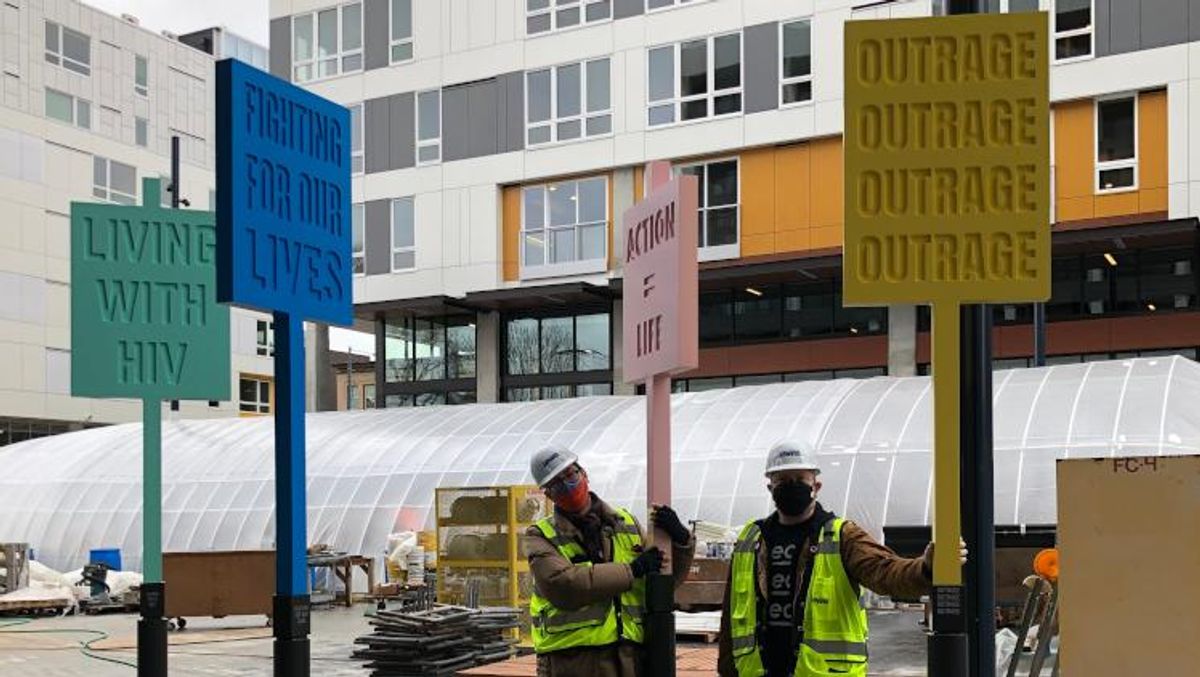News
Take a Peek at Seattle's Expansive, Years-in-the-Making AIDS Memorial

Four pieces of artwork are spread throughout the city's LGBTQ+ neighborhood.
March 16 2021 3:12 PM EST
By continuing to use our site, you agree to our Privacy Policy and Terms of Use.

Four pieces of artwork are spread throughout the city's LGBTQ+ neighborhood.
A volunteer-driven effort in Seattle is presenting the history of HIV and AIDS in Washington State through a public art project, the AIDS Memorial Pathway.
The pathway extends through several blocks in the Capitol Hill neighborhood and will incorporate four artworks, two of which have already been installed. It is designed to share stories about the epidemic and serve as a call to action to end HIV and AIDS as well as the associated stigma.
The first installation, In This Way We Loved One Another by artist Storme Webber, was completed in December (see below). It features photos plus incorporates text from people directly affected by AIDS, with a focus on women and people of color. It is aimed at “restoring missing narratives of working-class activists, healers, leaders, witnesses and ancestors lost to the AIDS crisis,” according to an AMP press release. It is located in the Cathy Hillebrand Community Room inside Community Roots Housing’s Station House building.
The second, We’re Already Here by the Civilization design practice, consists of three groupings of sculptures shaped like protest signs and bearing messages that evoke historic moments in the crisis, such as “Dream Big End AIDS,” “Women ACT UP,” and “Stop the Stigma.” The title comes from a quote from Seattle activist Brian Day, who was leading a demonstration to build support for an AIDS care center in the area. A Seattle Times reporter asked him about neighborhood residents who feared having people with AIDS in the area, and he replied, “We’re already here.” Installed in February, the sculptures are located in the plaza above the Capitol Hill Link light rail station and on the adjacent corner of Cal Anderson Park.
Two other artworks are scheduled for completion this spring and summer. Christopher Paul Jordan’s andimgonnamisseverybody will be a 20-foot-tall sculpture made of silent speaker equipment that he says “exists both to celebrate the lives of those no longer with us and to galvanize ongoing action.” The speakers form an X, or a positive sign on its side. It is meant to evoke the spaces created by Black, brown, poor, trans, queer, and otherwise excluded communities to take care of our own. It will be in the Central Plaza.
Ribbon of Light by Horatio Hung-Yan Law will be a series of three human-scale illuminated sculptures along a landscaped pathway adjacent to the main trail on the north edge of Cal Anderson Park. Inspired by the words of poets affected by the AIDS pandemic, the works will represent pieces of the sky that have broken into sculptural fragments and fallen to the ground, highlighting the changing nature of grief and providing places of mourning, reflection, and contemplation.
“The AMP will bring an important part of Seattle’s history to life,” Michele Hasson, steering committee chair for the AMP, said in a press release. “With each artwork’s public installation and as we get closer to the completion of the AIDS Memorial Pathway, the anticipation is building in the community. The artists have created powerful works that showcase the moving journey of the AIDS epidemic in our region. Thousands suffered, experienced discrimination and died during this public health crisis, but a strong community came together to create organizations and services that are still in operation today. We’re excited to share the efforts of so many that made the AMP possible.”
The project has been in development since 2015, when a group of volunteers came together to plan it. It is funded by community partners, public funds, and private donations. Find out more and see more images at TheAMP.org.